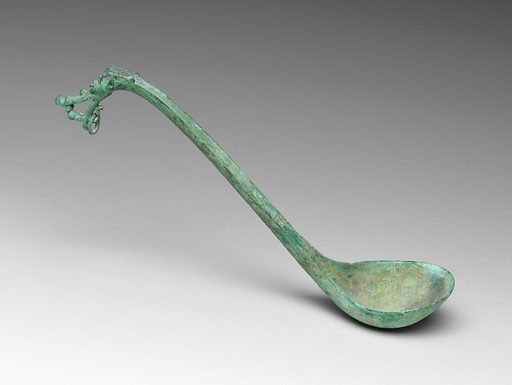Your Cart is Empty
FREE Worldwide Shipping! | +1 365 654 6605
FREE Worldwide Shipping! | +1 365 654 6605
August 10, 2023 4 min read

A ladle, derived from the Old English word meaning scoop or shovel, is a long-handled utensil ending in a deep bowl-like scoop. Primarily used for serving liquids like soup, stew, or gravy, the ladle has proven its versatility over centuries by evolving into various forms and adapting to different uses. The use of ladles dates back to antiquity. Excavations at ancient Egyptian, Greek, and Roman sites have unearthed ladles made from materials like wood, bone, or bronze. These early ladles were likely used for serving oils and soups. During the medieval period, ladles made of metal were commonly used during large feasts and also in religious rituals, such as the Communion service in Christian churches. In the pre-Hispanic Southwest, ladles or scoops were used much like serving spoons today. The scarcity of silver in 18th century England led to the emergence of simpler, more slender ladles in the Queen Anne style. These ladles often had a coin melded in their bowls - a practice born out of the balance needed due to the change in material composition. This has resulted in the discovery of ladles bearing the imprint of 18th-century English coins. Modern ladles are usually made from stainless steel, plastic, or silicone. They continue to serve their original purpose and have found new uses, like scooping ice cream or candy. When asked, "What is a ladle used for?", most people might think of soup or stew. However, ladles are versatile tools used for various purposes in the kitchen and in serving food. The primary use of a ladle is to serve soup, stew, or other liquid foods. Its deep bowl end can hold enough food to serve multiple people at once. The slender and twisted handle of certain ladles suggests that they were used to serve punch or hot toddy, a warm bourbon-based beverage. Slotted ladles, equipped with slots or holes in the bowl, are used for straining liquids or removing solid pieces from a liquid. Modern ladles have found additional uses in serving ice cream or candy. Ladles come in different shapes and sizes, each designed for specific purposes. Soup ladles have a deep bowl and are typically larger than other types of ladles. They are used for serving soup or other liquids. Gravy ladles have a small bowl and a long handle. They are typically smaller than soup ladles and are used for serving gravy or other sauces. Punch ladles have a large, shallow bowl and are used for serving punch or other drinks. Dipper ladles have a deep bowl and are used for scooping liquids out of a container. As mentioned earlier, slotted ladles are used for straining liquids or removing solid pieces from a liquid. These ladles are smaller than soup ladles and are used for serving iced tea, coffee, or other cold drinks. Candy ladles are smaller than gravy ladles and are used for scooping and pouring candy, caramel, or other sticky materials. In Huguenot Street, a slender ladle with a two-sided coin-shaped medallion at the bottom of its head represents more than just a utensil. It tells stories of public taste, migration from Europe to the Americas, and even treason. In Puerto Rico, a ladle or cucharón made from a gourd bowl with a wooden handle is often used to get water from the tinajero (water filter). This ladle holds cultural significance, as it has been used for generations. At the Yellow Jacket archaeological complex in southwestern Colorado, a McElmo black-on-white clay ladle found from the Pueblo II era (900-1150) offers a glimpse into the cultural practices of the period. In Thomas Jefferson’s Monticello, a silver ladle made by silversmith James Tookey in 1764/65 holds historical significance. It was part of the silverware Martha Wayles Skelton brought to the household after her marriage to Thomas Jefferson. When buying a ladle, consider the material, usage requirement, and design. Ladles can be made from plastic, melamine, stainless steel, wooden, or silicone. Depending on your need, you can choose from soup ladles, water ladles, or slotted ladles. Some popular ladle brands include Amico, Godinger, Oneida, Ginkgo, and Harold Imports. Ladles offer archaeologists a glimpse into the past. From individual ladle rim sherds showing wear from use, to larger portions of ladle bowls that indicate the handedness of the user, ladles help build a narrative about ancient cultures. As technology advances, so too does the design and functionality of ladles. Future ladles may feature innovative designs and materials to better suit our evolving culinary needs. The ladle serves as a testament to human ingenuity and adaptability. From its primitive origins to its current versatile forms, the ladle has proven its indispensability in the culinary world. As we continue to innovate and evolve, the ladle will undoubtedly continue to be a vital part of our culinary journey.
II. The Historical Journey of Ladles
A. Ancient Origins
B. Medieval and Pre-Hispanic Times
C. Ladles in the 18th and 19th Centuries
D. Ladles in the 20th Century and Beyond
III. The Multifaceted Uses of Ladles
A. Serving Liquids
B. Serving Punch or Hot Beverages
C. Straining Liquids
D. Serving Ice Cream or Candy
IV. Different Types of Ladles
A. Soup Ladle
B. Gravy Ladle
C. Punch Ladle
D. Dipper Ladle
E. Slotted Ladle
F. Iced Tea or Coffee Ladle
G. Candy Ladle
V. Ladles: A Symbol of Cultural Heritage
A. Ladles in Huguenot Street
B. Ladles in Puerto Rico
C. Ladles in the Yellow Jacket Archaeological Complex
D. Ladles in Thomas Jefferson’s Monticello

VI. How to Buy a Ladle
VII. Popular Ladle Brands
VIII. Ladles and Archaeology
IX. The Future of Ladles
X. Conclusion
Refrences
Be the first to know about upcoming sales and promos. Get a 10% discount coupon when you subscribe!